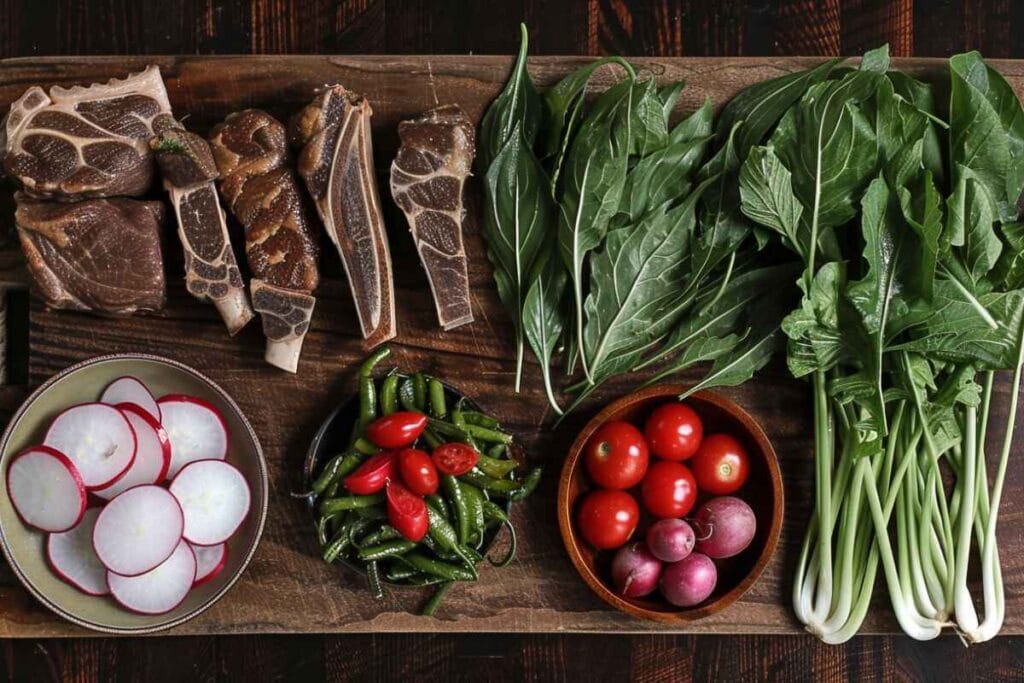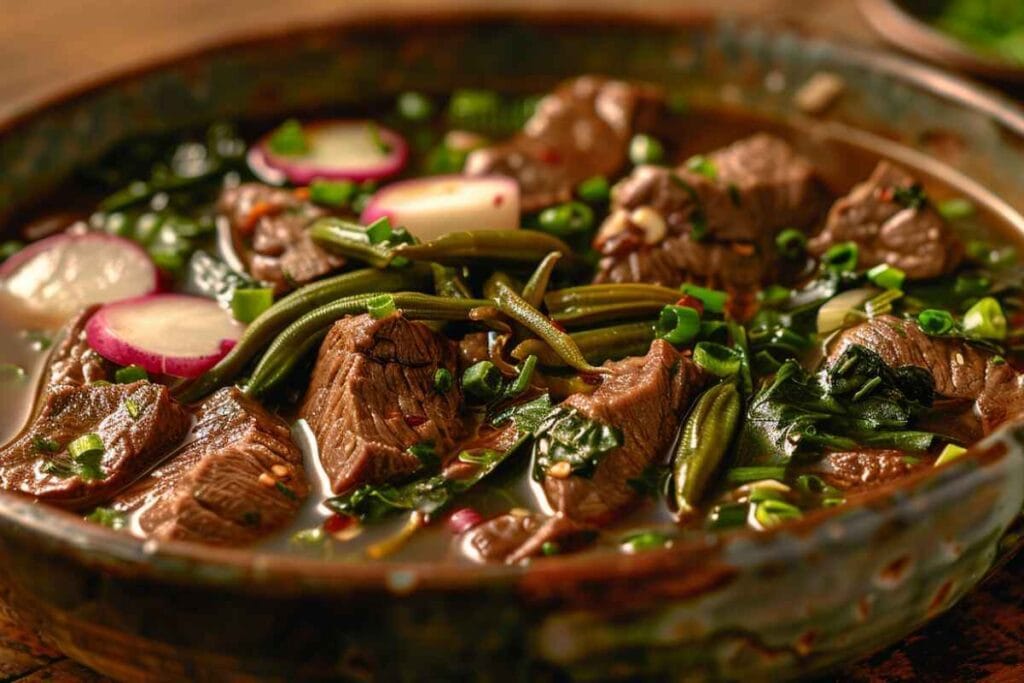Sinigang is more than just a dish; it’s a comforting hug in a bowl that captures the heart and soul of Filipino cuisine. Known for its distinct tangy flavor, this beloved sour soup is a staple in Filipino households, often served during family gatherings, special occasions, or even just as a cozy weeknight meal. What makes sinigang so special? It’s the perfect balance of savory, sour, and fresh flavors, thanks to a medley of ingredients like tamarind, vegetables, and tender meats.
Picture this: a rainy evening, the aroma of tamarind wafting through your kitchen, and a steaming bowl of sinigang warming your hands. This dish is not just food; it’s an experience.
But why is sinigang so universally loved? Its versatility. You can use beef, shrimp, beef, or even fish as your protein base, making it adaptable to whatever you’re craving. Let’s dive into everything you need to know to master this classic Filipino recipe at home.
“Sinigang isn’t just a dish; it’s a flavor journey that takes your taste buds on an unforgettable ride.”
Ingredients for Sinigang Recipe
When it comes to sinigang, the magic lies in its ingredients. Each one plays a crucial role in creating that perfect harmony of flavors. Here’s what you’ll need:

- Protein: Choose from beef (often ribs or belly), shrimp, beef, or fish. beef sinigang is the most popular version.
- Sour Base: Tamarind paste or fresh tamarind pods are traditional, but calamansi, green mangoes, or sinigang mix can also work.
- Vegetables: Classic choices include kangkong (water spinach), sitaw (long beans), radish, eggplant, okra, and tomatoes.
- Aromatics: Onions, garlic, and ginger to build a flavorful base.
- Seasonings: Fish sauce, salt, and black pepper for seasoning.
- Water or Broth: The foundation for your soup.
Optional but delightful add-ins include gabi (taro root) for extra creaminess or chili peppers for a spicy kick.
Pro tip: Fresh ingredients are non-negotiable for sinigang. They elevate the dish from good to absolutely divine.
Tools Needed for Preparing Sinigang Recipe
Cooking sinigang doesn’t require fancy equipment, but having the right tools makes the process smoother:
- Large Pot: A heavy-bottomed pot or Dutch oven is perfect for cooking the soup evenly.
- Knife and Cutting Board: For chopping all your fresh ingredients.
- Ladle: For stirring and serving.
- Strainer or Fine Sieve: If you’re using fresh tamarind pods, this will help extract the juice.
- Measuring Spoons and Cups: To get the ratios just right, especially if you’re using tamarind paste.
“The right tools aren’t just for efficiency—they’re for ensuring your sinigang tastes as authentic as possible.”
Step-by-Step Guide for Sinigang Recipe
Now that you have your ingredients and tools ready, let’s break down the cooking process step by step.
Preparing
Before you start cooking, prep work is key to a seamless sinigang experience.
- Prep Your Protein: If using beef, cut it into manageable pieces. For shrimp or fish, clean and devein as needed. Beef cuts should be trimmed of excess fat.
- Wash Your Vegetables: Rinse thoroughly under running water to remove dirt and debris.
- Chop Vegetables: Cut the radish into thin slices, chop kangkong into manageable pieces, and slice eggplants into wedges.
- Prepare the Tamarind Base: If using fresh tamarind pods, boil them in water until soft, then mash and strain to extract the juice.
Once everything is prepped, you’re ready to cook.
Cooking
Here’s where the magic begins:
- Sauté Aromatics: Heat a splash of oil in your pot. Add onions, garlic, and ginger, stirring until fragrant.
- Cook the Protein: Add your chosen protein and cook until it’s lightly browned or partially cooked.
- Add Water or Broth: Pour in enough liquid to cover the ingredients. Bring it to a gentle boil.
- Simmer: Reduce the heat and let the protein cook until tender. For beef, this might take 30-40 minutes. Shrimp and fish require less time, about 10-15 minutes.
- Add Vegetables: Start with the heartier ones like radish and taro. After a few minutes, add eggplant, okra, and sitaw.
- Season: Stir in the tamarind juice or paste, fish sauce, salt, and pepper. Taste and adjust as needed.
- Final Touches: Add delicate greens like kangkong last, letting them wilt for just a minute or two before serving.
“Cooking sinigang is like orchestrating a symphony—each step adds a layer of flavor to the masterpiece.”
Assembling
When it’s time to serve, presentation matters just as much as the taste.
- Serve Hot: Ladle the soup into bowls, making sure each serving has a good balance of protein, vegetables, and broth.
- Garnish: Add a sprinkle of freshly chopped green onions or a squeeze of calamansi for extra zest.
Pair your sinigang with steamed rice for the ultimate Filipino comfort meal.
Serving Suggestions for Sinigang Recipe
Sinigang is a dish that thrives on simplicity and heartiness, but how you serve it can take the experience to the next level. Here’s how to make your sinigang truly shine:
- Pair It with Steamed Rice: A classic pairing, steamed white rice is the perfect canvas to soak up the flavorful, tangy broth of sinigang. For a healthier option, brown rice or quinoa can also work.
- Add a Side of Condiments: Serve fish sauce with chopped chili on the side for those who love a salty-spicy kick. You can also offer calamansi or lemon wedges for an added citrusy punch.
- Serve Family-Style: Sinigang is best enjoyed with company. Place a large pot of soup in the middle of the table and let everyone serve themselves. It’s a great way to bring people together.
“Sinigang isn’t just food; it’s an experience that’s best shared with loved ones around a table.”
For special occasions, consider complementing your sinigang with other Filipino dishes like lumpia (spring rolls), adobo, or grilled seafood. A cold glass of calamansi juice or iced tea completes the meal perfectly.
Variations of Sinigang Recipe
Sinigang is a dish that encourages creativity. With a few tweaks, you can tailor it to suit dietary preferences, available ingredients, or even your mood. Let’s explore some popular and innovative variations:
Dietary_Adjustments
Whether you’re catering to dietary restrictions or simply looking for a healthier version, sinigang can adapt beautifully:
- Vegetarian Sinigang: Skip the meat and use tofu or mushrooms as the protein source. Add more vegetables like zucchini, bok choy, and bell peppers to make it hearty.
- Low-Sodium Version: Use low-sodium broth and reduce the amount of fish sauce. Let the natural flavors of the vegetables shine.
- Gluten-Free Option: Ensure that your fish sauce and tamarind mix are gluten-free. Most brands are, but it’s always good to double-check.
Flavor_Enhancements
Want to elevate the flavor of your sinigang? Here are some ideas:
- Roast Your Vegetables: Roasting tomatoes, radishes, or eggplants before adding them to the soup brings out their natural sweetness and adds depth to the dish.
- Add Coconut Milk: For a richer, creamier version, stir in coconut milk toward the end of cooking. This twist is often referred to as “Sinigang sa Gata.”
- Spicy Kick: Add bird’s eye chilies or cayenne pepper for a spicy sinigang that warms you up even more.
“The beauty of sinigang lies in its ability to evolve, making every bowl unique and special.”
Common Mistakes and How to Avoid Them for Sinigang Recipe
Even seasoned cooks can make mistakes when preparing sinigang. Here are some common pitfalls and tips to sidestep them:
- Overcooking the Vegetables: No one likes mushy veggies. Add them in stages based on their cooking times, starting with the heartiest ones.
- Too Salty or Too Sour: Balance is key. Start with small amounts of tamarind paste and fish sauce, then adjust to taste. You can always add more, but you can’t take it out.
- Not Using Fresh Ingredients: Fresh vegetables and aromatics make a world of difference. Avoid canned or frozen versions unless absolutely necessary.
- Skipping the Simmer: Rushing the cooking process can result in a lackluster broth. Take your time to let the flavors meld together.
Pro Tip: “Taste as you go. The secret to a great sinigang lies in finding the perfect balance of sour, salty, and savory.”
Nutritional Benefits of Sinigang Recipe
Sinigang is more than just a comfort food; it’s a nutrient-packed meal that can support a healthy lifestyle.
Health_Benefits
This dish is a powerhouse of health benefits thanks to its fresh ingredients:
- Rich in Vitamins and Minerals: The vegetables in sinigang, such as spinach, radish, and tomatoes, are loaded with vitamins A, C, and K, along with essential minerals like potassium and magnesium.
- Protein Boost: Depending on your choice of protein, sinigang provides a healthy dose of essential amino acids to support muscle repair and growth.
- Low in Calories: Sinigang is generally low in calories, making it a great choice for those watching their intake without sacrificing flavor.
Calories and Macronutrients
Curious about the nutritional breakdown? Here’s an approximate analysis for a serving of beef sinigang:
- Calories: 250-300 (depending on the cut of beef and portion size)
- Protein: 20-25g
- Carbohydrates: 10-15g
- Fats: 10-15g
These values can vary based on the ingredients used, but the dish is generally balanced and nutrient-dense.
Pairing Suggestions for Sinigang Recipe
Sinigang is already a star on its own, but pairing it with complementary dishes can elevate your meal to a whole new level. Here are some ideas to round out your sinigang feast:
- Crispy Fried Dishes: A serving of crispy beef belly or fried fish balances the tanginess of sinigang with a delightful crunch.
- Grilled Favorites: Grilled eggplant, squid, or even chicken inasal (Filipino-style grilled chicken) pairs wonderfully with the bold flavors of sinigang.
- Simple Sides: A side of garlic fried rice or plain steamed rice is a classic pairing that lets sinigang take center stage.
- Refreshing Drinks: Cool off the tangy richness with calamansi juice, coconut water, or a light cucumber lemonade.
For dessert, consider something light and sweet like fresh mango slices or a bowl of halo-halo, a traditional Filipino shaved ice treat.
“Pairing sinigang with the right dishes is like finding the perfect harmony in a song—it just works.”
Frequently Asked Questions
What are some interesting facts about sinigang?
Sinigang is considered one of the most iconic dishes in Filipino cuisine due to its distinct sour and savory flavor. Its origins can be traced back to indigenous cooking traditions that heavily relied on fresh, natural ingredients. The dish’s name comes from the Filipino word “sigang,” which means “to stew.” Interestingly, tamarind is the traditional souring agent, but modern versions sometimes use calamansi, green mango, or even guava. Sinigang is also highly versatile, with popular variations featuring beef, shrimp, fish, or beef.
How long can I keep sinigang?
Sinigang can be stored in the refrigerator for up to 3 days when kept in an airtight container. If you want to keep it longer, freezing is a great option. Frozen sinigang can last up to 3 months, but for the best quality, consume it within the first month. When reheating, ensure it is heated thoroughly to maintain its flavor and safety.
What ingredients of sinigang are mentioned in the selection?
The ingredients mentioned include:
- Protein: beef, shrimp, beef, or fish.
- Sour Base: Tamarind paste, fresh tamarind pods, calamansi, green mangoes, or sinigang mix.
- Vegetables: Kangkong (water spinach), sitaw (long beans), radish, eggplant, okra, and tomatoes.
- Aromatics: Onion, garlic, and ginger.
- Seasonings: Fish sauce, salt, and black pepper.
- Optional Add-ins: Taro root (gabi) and chili peppers.
These ingredients are essential for creating the signature flavor and texture of sinigang.
What are the benefits of eating sinigang?
Sinigang is not just delicious but also offers several health benefits:
- Rich in Nutrients: It’s packed with vitamins and minerals from the vegetables, such as vitamin C, potassium, and fiber.
- Low-Calorie Meal: Sinigang is a light yet satisfying dish, making it ideal for those watching their caloric intake.
- Hydration: The broth is hydrating and soothing, especially on cold or rainy days.
- Boosts Digestion: Tamarind, a common souring agent, is known for aiding digestion and promoting gut health.
- Protein-Packed: The meat or seafood in sinigang provides a good source of protein, essential for muscle repair and overall health.
Sinigang is the perfect combination of comfort food and a nutritious meal, making it a favorite for people of all ages.
Conclusion for Sinigang Recipe
Sinigang is more than just a dish; it’s a celebration of Filipino culture and culinary ingenuity. Its unique tangy profile, hearty ingredients, and versatility make it a staple that transcends generations and geographical boundaries. Whether you’re cooking for family, hosting a dinner party, or just treating yourself, sinigang never fails to bring warmth and joy to the table.
So why not try making this timeless classic in your kitchen? It’s easier than you think, and the payoff is a dish that comforts your soul with every spoonful.

Final_Thoughts
As you savor your bowl of sinigang, take a moment to appreciate the layers of flavor and the stories behind every ingredient. From the sourness of tamarind to the earthiness of the vegetables, every element contributes to a symphony of tastes that’s both simple and complex.
“Sinigang is a dish that proves comfort food doesn’t have to be complicated—it just has to be made with love.”
Call to Action
Ready to bring the taste of the Philippines to your kitchen? Try this sinigang recipe today and let us know how it turns out. What protein and vegetables did you use? Did you put your own spin on it? Share your experiences in the comments below!
Who’s digging in tonight?

